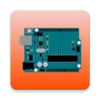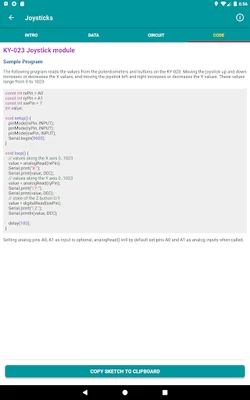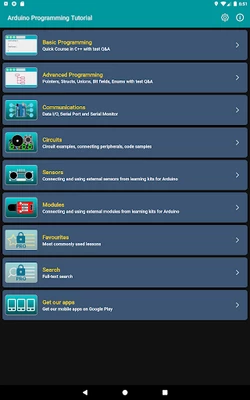
Arduino Programming Tutorial
- 5.0 RATINGS
- 54.00MB DOWNLOADS
- 4+ AGE
About this app
-
Name Arduino Programming Tutorial
-
Category GENERAL
-
Price Free
-
Safety 100% Safe
-
Version 3.22
-
Update Jul 10,2024



In today's digital age, the Arduino platform has become a pivotal tool for aspiring programmers, makers, and hobbyists alike. Its simplicity, versatility, and cost-efficiency have made it a household name in the world of DIY electronics. This article aims to provide a comprehensive Arduino programming tutorial for beginners, guiding them through the essential steps of getting started with Arduino programming.
Firstly, let's delve into the fundamentals of Arduino. Arduino is an open-source hardware and software platform that allows users to create interactive electronic projects. It consists of a microcontroller board, typically powered by the Atmel AVR microchip, and a software development environment called the Arduino IDE (Integrated Development Environment).
To begin programming an Arduino, you'll need to set up the Arduino IDE on your computer. This software is available for free and can be downloaded from the official Arduino website. Once installed, you'll be able to write and compile code for your Arduino board.
The Arduino IDE uses the C/C++ programming language, which is widely used in embedded systems development. However, the Arduino IDE abstracts away many of the complexities of C/C++, making it easier for beginners to understand and use. The IDE also provides a built-in serial monitor, which allows you to communicate with your Arduino board and view any serial data it sends.
The first step in Arduino programming is to connect your Arduino board to your computer using a USB cable. Once connected, the Arduino IDE should recognize your board and display it in the "Board" section of the IDE's "Tools" menu. You'll also need to select the appropriate USB port in the "Port" section of the "Tools" menu.
Now, let's write a simple program to blink an LED connected to your Arduino board. Open a new sketch in the Arduino IDE (a sketch is simply a program written for the Arduino). In the code window, you'll find two main functions: `setup()` and `loop()`. The `setup()` function is called once when the Arduino starts, and it's where you'll initialize any pins or variables you'll need for your program. The `loop()` function, on the other hand, is called repeatedly, allowing you to define the ongoing behavior of your program.
Here's a basic example of code that blinks an LED connected to digital pin 13 on the Arduino board:
```cpp // Define the pin connected to the LED #define LED_PIN 13 void setup() { // Initialize the LED pin as an OUTPUT pinMode(LED_PIN, OUTPUT); } void loop() { // Turn on the LED digitalWrite(LED_PIN, HIGH); // Wait for a second (1000 milliseconds) delay(1000); // Turn off the LED digitalWrite(LED_PIN, LOW); // Wait for a second delay(1000); } ```
After writing your code, you can compile and upload it to your Arduino board by clicking the "Upload" button in the IDE. Once uploaded, your Arduino board will start executing the code, and you should see the LED connected to digital pin 13 blinking.
This tutorial covers only the basics of Arduino programming, but it provides a solid foundation for further exploration. With the Arduino IDE and a basic understanding of C/C++, you can create a wide range of interactive projects, from simple LED blinkers to complex robotic systems.
Remember, the best way to learn is by doing. Experiment with different sensors, actuators, and code examples to gain a deeper understanding of the Arduino platform and its capabilities.






